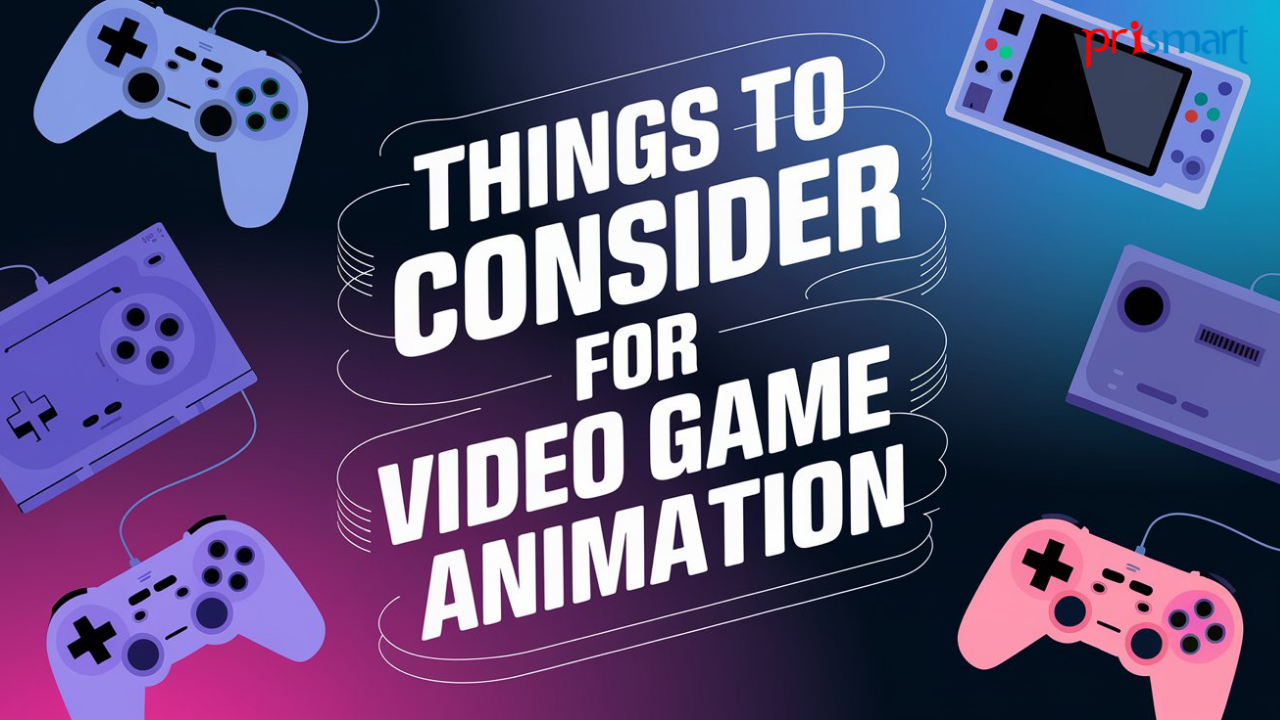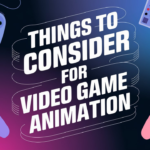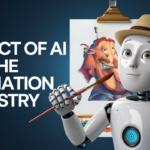Hello Game lovers! Well, I’m considering you to have a strong passion for Video Games if you are reading my blog. Let me tell you, this is going to be worth a read! In this blog post, I’m gonna cover the history of Video Game animation, types of video game animation, principles of game animation, and factors to consider for video game animation. Additionally, I’ll also be revealing how to choose the best video game animation studio in India for the best prices, quality output, and minimum turnarounds.
History and Evolution of Video Game Animation
The journey of video game animation has come a long way since the days of Pong and Space Invaders, where games featured basic motion and 2D graphics. Technological innovations introduced pixel art and sprites (2D bitmap graphics) in games such as Pac-Man and Donkey Kong.
In the 1990s, there ushered a new revolution in the history of video game animation. Games like Doom and Wolfenstein 3D used 3D polygonal models. 3D animation changed the way video games looked with realistic environments, characters, and interactive elements. In addition to this, motion capture (mocap) brought significant developments in the gaming experience.
Types of Animation in Video Games
Game animation gives life to characters, environments, and visual effects in video games. Game animators should possess video game animation skills including proficiency in animation, understanding of animation software, creativity, keen observation, and strong communication skills.
There are several types of animation techniques used in video games, such as 2D animation, 3D animation, motion capture, and stop motion. Let’s explore some of the key types of animation used in game design.
- Character Animation
Video Game Character animation breathes life into the characters by giving them natural movements, gestures, and actions. Whether you have a comic, superhero, or villainous character, character animation brings the personality of in-game characters to life.
- Facial Animation
With Facial animation, it becomes possible to animate the character’s expressions, lip-syncing, and subtle movements. Game animators focus on facial anatomy to depict facial expressions that convey emotions and make characters more believable.
- Environmental Animation
Environmental animation allows game animators to design landscapes, props, and architecture that build the story and give emotional cues to the players. Gaming animators use environmental animation to create realistic environments and stimulate the audience’s interest.
- Object Animation
Using object animation, animators can animate props, doors, and surrounding scenery like trees and weather patterns. Object animation engages the players by ensuring it is responsive to the player’s actions and also improves the gameplay mechanics.
- Cutscene Animation
Cutscene animation builds a game’s narrative, raises tension, and evokes emotions by creating detailed cinematic cutscenes, character development, or dramatic moments. Well-crafted animations draw players deeper into the story and give them a unique gaming experience.
- Physics-based Animation
Physics-based animation relies on laws of physics to create realistic movements in the game environment. Game developers use this animation technique to create environment effects, simulations, and real-time interactions between the characters and the objects.
Ten Principles of Video Game Animation
To create animations that resonate with players, game animators often follow the classic animation principles:
- Squash and Stretch: Emphasizes motion by changing an object’s shape to indicate impact or speed. It considers object weight, liveliness, and flexibility to make the animation engaging.
- Staging: Directs player focus to key game elements by arranging characters, scenes, objects, and backgrounds in a clear and simple-to-understand manner.
- Anticipation: Prepares players for an upcoming action by integrating small movements before the big action, enhancing the sense of realism.
- Straight Ahead vs. Pose to Pose: Using straight head animation technique to create fluid and natural movements for fast actions. In the Pose to Pose technique, in-between frames are utilized to connect the positions of characters.
- Follow Through and Overlapping Action: The Follow Through principle ensures that parts of the character continue to move naturally after an action. In Overlapping Action, the focus is on moving different body parts of the character at varying times to depict realism.
- Arcs: Arcs are applied to align curved paths to show natural movements and make the animation not look mechanical and unnatural. This is applied for movements, facial expressions, etc.
- Slow In and Slow Out: Ensures gradual acceleration and deceleration to mimic real-world physics and stop movements that look unnatural to the player.
- Exaggeration: Enhances key movements or emotions for emphasis, especially in action or cartoon-style games. This makes characters easily identifiable and conveys emotions more clearly.
- Appeal: Designs characters and animations that are visually engaging and memorable by giving them clear and distinctive shapes, proportions, and features.
- Timing and Spacing: Controls the speed and rhythm of actions to suggest slow or fast movement. Also, maintaining space between each frame in action creates an illusion.
Factors to Consider for Game Animation

In developing video game animations, there are several critical considerations that animators and developers need to keep in mind. These include:
- Performance and Optimization
Game animation must run in real-time, giving players real-time interaction. To ensure this, it is important to balance performance and quality and carefully optimize the game on multiple devices.
- Polygon count: Keeping characters and objects as low-poly models while maintaining visual appeal.
- Texture resolution: Using appropriate texture sizes for details without overloading the system.
- Animation complexity: Using simple animations to focus on essential movements without straining performance.
- Responsiveness
Responsive animations are critical to maintaining player engagement. Players expect immediate feedback when performing actions, such as jumping or attacking.
- Minimizing animation startup: Reducing frames for action like an attack or escape.
- Animation blending: Blend animations smoothly to create a more natural look. –
- Animation canceling: For a seamless gameplay experience, allow important player actions to interrupt ongoing animation.
- Style and Consistency
Animation style must align with the game’s overall aesthetic and remain consistent across characters and objects.
- Style guide: To ensure that animations meet the artistic vision, animators should follow guidelines for movement, timings, and exaggeration.
- Target audience: To meet the preferences of the player base, it is important to tailor your animation style according to them.
- Consistency: To ensure uniformity in animation design for different characters, environments, and gameplay elements.
- Gameplay Integration
Animations should always improve gameplay mechanics rather than hinder them.
- Hitboxes and collision detection: Ensuring that animations align with gameplay elements for accurate gameplay feedback.
- Telegraph actions: Using animations to signal enemy attacks or player actions, providing visual cues.
- Support for game feel: Crafting animations that reflect the weight, speed, and impact of characters’ actions.
- Reusability and Modularity
Creating reusable animations can save time and resources, especially for large game projects.
- Base animation sets: Develop animations that can be modified and repurposed for different characters or scenarios.
- Procedural animation: Leveraging algorithms to adapt animations dynamically for varied in-game situations.
- Environmental Interaction
Animations must account for interactions with the environment to make characters feel grounded in the game world.
- Surface adaptation: Adjusting character movement based on terrain types (e.g., inclines or slippery surfaces).
- Dynamic obstacles: Creating animations for interacting with objects like doors, vehicles, or environmental hazards.
- Narrative and Emotion
Character animations can be used to convey emotion, personality, and story.
- Expressive facial animations: Ensuring that characters’ faces reflect their emotions during dialogues or cinematic moments.
- Cinematic animations: Creating detailed animations for key plot moments to heighten the emotional impact.
Find the Best Video Game Animation Services for You!
Animation is a powerful tool in video games, capable of transforming static pixels into dynamic, living worlds. Game animators should create realistic, immersive, dynamic, VR, and AR-integrated games optimized for multiple devices and platforms.
Are you looking for the best gaming animation services? Contact Prismart Productions, the recognized leader in gaming animation services for over a decade. We have unique ideas, trained teams, the latest software, and expertise to create high-quality and visually stunning games. Prismart specializes in all types of game animation to bring game worlds to life.
Get in touch with the leader of game animation, Prismart, for:
- End-to-end process
- Smooth handling
- Effective communication
- High Attention
- Low Prices
- Quality Output
- Tech expertise
- Creative vision




